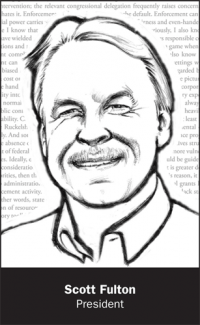Polarization Has Increased Over Three Decades, Making the Swings Wilder and More Upsetting

I was there, on October 18, 1995, attending my first ELI Award Dinner as a newly minted deputy regional administrator in EPA’s Region 6 office. By then, I had been with the agency for 18 years and witnessed the shifts from the Carter administration to presidents Reagan, Bush, and Clinton. I heard the award winner, William D. Ruckelshaus, a mythic figure at EPA, deliver the now-famous “Pendulum Speech”—reprinted as the cover story in the next Environmental Forum, and again in this issue three decades later. Little did I know that this metaphor would have such enduring power, and that the swings of the pendulum, far from dampening, would amplify.
The pendulum, however, is not still swinging in the same arc. Today there are similarities with the era Ruckelshaus evoked in his remarks, but there are also many differences. Let’s start with what hasn’t changed: the degeneration of political rhetoric around the environment. 1995 was an early stage, kicking off with the Contract With America and the flourishes of Speaker of the House Newt Gingrich and his allies, encouraging the use of words such as “bizarre,” “corruption,” “pathetic,” “radical,” “sick,” “traitors,” and perhaps most tellingly, “they/them” to describe others who were not political opponents, but enemies. Ruckelshaus’s reference to comparisons of EPA with the Gestapo finds its analog in calls during the 2024 campaign to “rescind every one of Joe Biden’s industry-killing, job-killing, pro-China and anti-American electricity regulations.”
A second similarity is that self-interested parties reinforce these rhetorical excesses. Wealthy fossil fuel advocates are eager to represent renewable energy supporters as elitists or, worse, as un-American. Environmentalists understandably respond in kind, with urgent appeals for funds to forestall an imminent apocalypse. Now, the apocalypse may indeed be coming, but your $10 contribution may not be sufficient when what is needed, to quote from Ruckelshaus’s speech, is “the application of intelligence, cooperation, and creativity” to solve extraordinarily complex problems.
Ruckelshaus observed that EPA found itself “staggering under the assaults of its enemies, while still gravely wounded from the gifts of its friends,” or rather that “EPA has no friends” in the form of a “coherent, politically potent constituency devoted to making sure that the EPA can make the best possible decisions and carry them out successfully.” In my experience, this can be exaggerated. Many responsible professionals with different policy views recognize the need for an EPA with the expertise to assess the facts and the law around difficult policy decisions and make transparent choices among responsible policy options. That said, with the latest extreme swings between Bush, Obama, Trump, Biden, and now Trump administrations, “battered agency syndrome,” in Ruckelshaus’s words, seems an apt description of the situation facing dedicated EPA career employees trying to fulfill the role he described. Threats by incoming political leaders to put EPA employees “in trauma” only make matters worse.
The pendulum swings in the mid-1990s reflected the ambitions of the early 1970s statutes and the implementation challenges these ambitions inevitably faced. By the time of Ruckelshaus’s speech, the often unattainable goals of these early laws had been addressed by Congress through amendment and reauthorization. However, the pattern of statutory adjustments in the 1970-90 period did not continue. With a few notable exceptions, in the last 30 years we have seen few bipartisan adjustments to the nation’s environmental laws, let alone the “single, unified statute” that Ruckelshaus called for. This has led both parties to rely on administrative flexibilities, with the 1984 Chevron decision providing a valuable pressure relief valve and enabling EPA to make use of existing authorities to address emerging problems.
Of course, this solution is now proscribed by the Supreme Court’s Loper decision last year—a critical difference between the track of Ruckelshaus’s pendulum and the one we see swinging today. There are many others:
Energy—Energy and environmental policy are always closely linked, but the ground has shifted in the last 30 years. In 1995, the United States imported a substantial amount of its energy needs. In 2025, thanks largely to hydraulic fracturing, the United States produces more oil and natural gas than it consumes—a development almost inconceivable 30 years ago. Cost-effective renewable sources of energy, if not expanding as quickly here as in Europe, continue to grow. Together with natural gas, these sources are displacing coal, whose combustion created so many of America’s environmental problems, as a source of electric power.
Economics vs. Culture Wars—Economic policy battles in the early 1990s were largely fought on the field of relative costs and benefits. Economics still matter, of course, but while we can better describe the benefits of environmental protection, it now seems irrelevant to public discourse. Rather than debate the economic merits of electric vehicles, one oil billionaire dismisses them as “virtue” cars while other critics attack them as effete and elitist, even as EVs approach price parity with comparable gas-powered vehicles.
Partisanship—1995 was an inflection point for the two political parties becoming what they are now: not extra-constitutional devices for electing presidents, but a source of identity and meaning for many Americans. Pew Research Center surveys between 1994 and 2017 show American political values becoming more strongly associated with partisanship. Even though majorities of the public don’t view either party favorably, for those who are members, antipathy between them is rising. Party discipline in Congress has become stronger, especially in the House, where gerrymandered districts guarantee election but enforce unity with threats of being “primaried.” Congressional parties will reverse long-held policy positions rather than allow the other party to achieve legislative success. In an evenly divided electorate, “winning” has become more important than solving problems.
Polarized News—There is no Walter Cronkite in today’s America. There is no common news; instead, we tailor our media consumption to outlets we believe share our values. Objectivity counts for less than identity. Worse may lie ahead; with the rise of artificial intelligence and its ability to both create compelling simulations of reality and to make errors in doing so, “fake news” may gain a new and more sinister meaning.
Money—The impact of money on politics is not new, of course, but the demise of efforts to reform campaign finance in the wake of the Citizens United case and the increasing concentration of wealth at the top of American society have created a class of politically active billionaires with the ability to invest virtually unlimited sums to achieve their objectives.
The Rule of Law—In 2000, respect for the rule of law and the integrity of the Supreme Court was sufficient for Vice President Al Gore to concede an extraordinarily close election following an adverse 5-4 decision on counting Florida ballots, even when a continuation of that process might well have reversed the outcome of the election.
Can anyone imagine such an outcome today? Certainly not the president-elect, who to this day contests the outcome of an election which he manifestly lost by a considerable margin. In 2021 this resulted in a previously unthinkable assault on the Capitol; today, serious people question whether the incoming administration would respect a Supreme Court decision with which the president disagrees. While these fears may be overstated, the fact that this is even a subject of discussion illustrates differences between America now and America in 1995.
Environmental Challenges— In 1995, Ruckelshaus referred to pendulum swings between pro- and anti-environmental “excess,” presuming his audience could understand (if not agree) on what these were. He spoke of the “enormous and beneficial” effect that EPA programs have had on American life. Yet a Gallup poll in March 2024 still shows that over half of the population believes the environment is getting worse, not better. The problems behind this perception, such as global warming, microplastics, and “forever” chemicals, are unlike the “gross pollution” that faced the first EPA administrator in 1970. Concerns such as environmental justice and sustainability were not on the agenda then; they certainly are now.
In an EPA oral history, Ruckelshaus said that in 1970 he thought that pollution could be solved by “mild coercion”; that if the federal government set standards and enforced them, the problem would essentially disappear. “I thought we knew what the bad pollutants were, knew at what levels they caused adverse health and environmental effects, and knew the technology needed to combat them. Finally, I thought all of this could be done at a reasonable cost within a reasonable time. I was there about three months when I began to question every single one of the assumptions I had entered the agency with.”
Now would be an excellent time for all of us to question our assumptions. Beyond tempering our rhetoric, we will have to admit that we might be wrong, examine our own biases, develop an awareness of our own risk preferences and why others may differ, and redevelop an ability to engage among communities with different values. We need not always presume good faith, but we must find ways to bargain among interests by means other than warring among hostile clans and cultures. The swinging pendulum has become a sling; the great leaders will be the ones who can find ways to encourage us to lay down our weapons and study political warfare less and environmental problems more.


